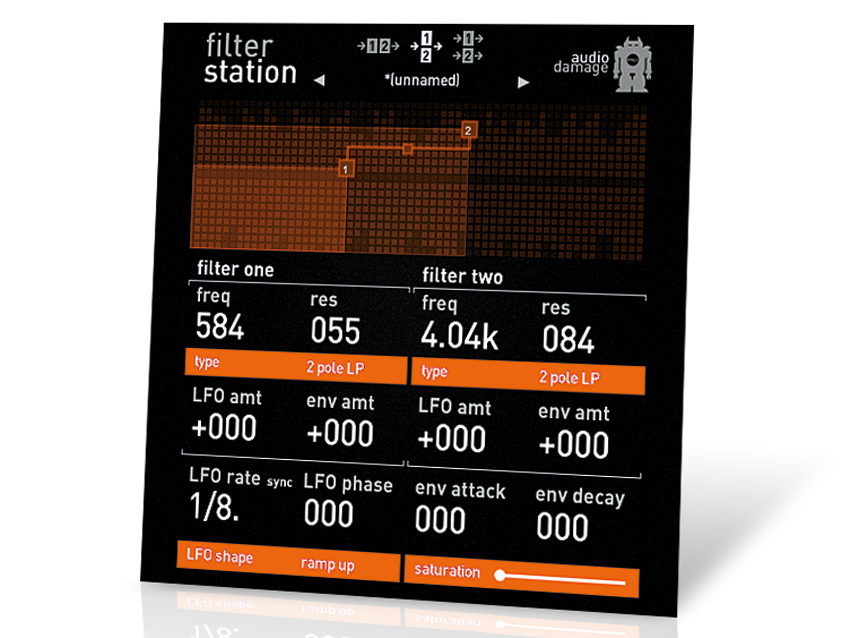MusicRadar Verdict
For a flexible, no-nonsense filter plug-in, Filterstation is bang on the money.
Pros
- +
Great sound and 12 filter modes; awesome interface; good presets; performance-friendly; very versatile.
Cons
- -
No sidechain on AU version; lacks input/output metering and gain.
MusicRadar's got your back
The concept is simple: take two multimode filters, an LFO and an envelope follower, and insert them into Audio Damage's efficient and stylish interface, throwing in a clever take on thegood old X/Y pad. The result is Filterstation, across-platform VST/AU plug-in.
The filter types can fizz, grind and sing with the best of them. For each of the two filter sections, you can choose from 12 filter types. There are some tasty Korg MS-20 emulations; various high-pass, low-pass, band-pass and notch types; and a VCA that isn't a filter at all but controls volume level instead.
Now, these two filter sections can be arranged in a few ways. First is Series, which runs the signal through one and then the other.
Next comes Parallel, in which the signal is split, run through each and then the outputs of both combined. Finally we have Stereo, in which the two filters are applied to the left and right channels.
A few of our favourite things
This last mode provides interesting possibilities. Filterstation's unique selling point is that it takes some simple features and then gets them to interact beautifully, making a number of filtering tricks incredibly simple to apply.
The stereo settings can have subtle or extreme results. By having slightly different frequency and resonance settings and then dragging both parameters around in the X/Y control, you can produce magical sweeps that appear to vary in stereo width.
The LFO can give rise to some wicked faux sidechain pumping effects, and you can use this to completely change the dynamics of a bassline or loop.
Want all the hottest music and gear news, reviews, deals, features and more, direct to your inbox? Sign up here.
The envelope follower is a gold mine, too. It can, for example, be applied independently to each filter. It can be employed for things like filters opening as sounds get louder, or low cuts being applied in between kicks on a loop, effectively killing the bottom end of an off-beat bassline automatically.
The X/Y control provides further scope for experimentation. Here, you get numbered handles that control the cutoff and resonance of each filter.
There's also a linked handle that lets you adjust both together in fixed relation to each other. It's a fantastic performance tool and can be easily automated.
Next is the LFO section. There are 12 shapes and the rate can be set manually or synced to the project. There's only one LFO, but you can set the amount of modulation (positive or negative) independently for each filter, which yields impressive variation.
Assigned to further modulation duties is an envelope follower that uses the incoming signal to modulate the filter. Like the LFO, you can use different modulation amounts on each one.
A simple saturation effect finishes things off, and the net total of all these seemingly simple elements is a plug-in that's capable of some mighty cool results.
AU kidding me?
One thing to be aware of is that although there is a sidechain version (the sidechain input replaces the envelope follower), it's VST3-only, with no Audio Unit version available.
To be really picky, we would point to the lack of input and output meters and gain controls. Even if they were available as a toggled sidebar they would help, particularly considering the ability to adjust your signal level when applying resonant filtering to full tracks in a live situation.
For such a simple plug-in, there is plenty of mileage to be had, however, and it's usefulness is not genre-specific. Filterstation can add bite and warmth, and its clever interactions mean that it can be employed as a creative effect, an exciter, a bass enhancer (a particularly impressive preset demonstrates this), a subtle phaser, a doppler, a tremolo, a gate and - wait forit - even a good-old basic filter.
It's fun, it's affordable, and while it doesn't rewrite the rule book, it does for the staple process of filtering what Audio Damage's excellent Panstation did just a few months ago for plain old panning.
Audio Damage plug-ins are often too esoteric and off-the-wall to be everyone's cup of tea, but there's none of that here. Say hello to the company's most universally essential purchase thus far.
Computer Music magazine is the world’s best selling publication dedicated solely to making great music with your Mac or PC computer. Each issue it brings its lucky readers the best in cutting-edge tutorials, need-to-know, expert software reviews and even all the tools you actually need to make great music today, courtesy of our legendary CM Plugin Suite.

